Leading Lean Project
VerifiedAdded on 2022/12/19
|11
|3741
|88
AI Summary
This report discusses the project management process for a leading lean project in the housing construction industry. It explores factors that affect the design and layout of a dream home and how lean project management can be implemented to achieve success.
Contribute Materials
Your contribution can guide someone’s learning journey. Share your
documents today.
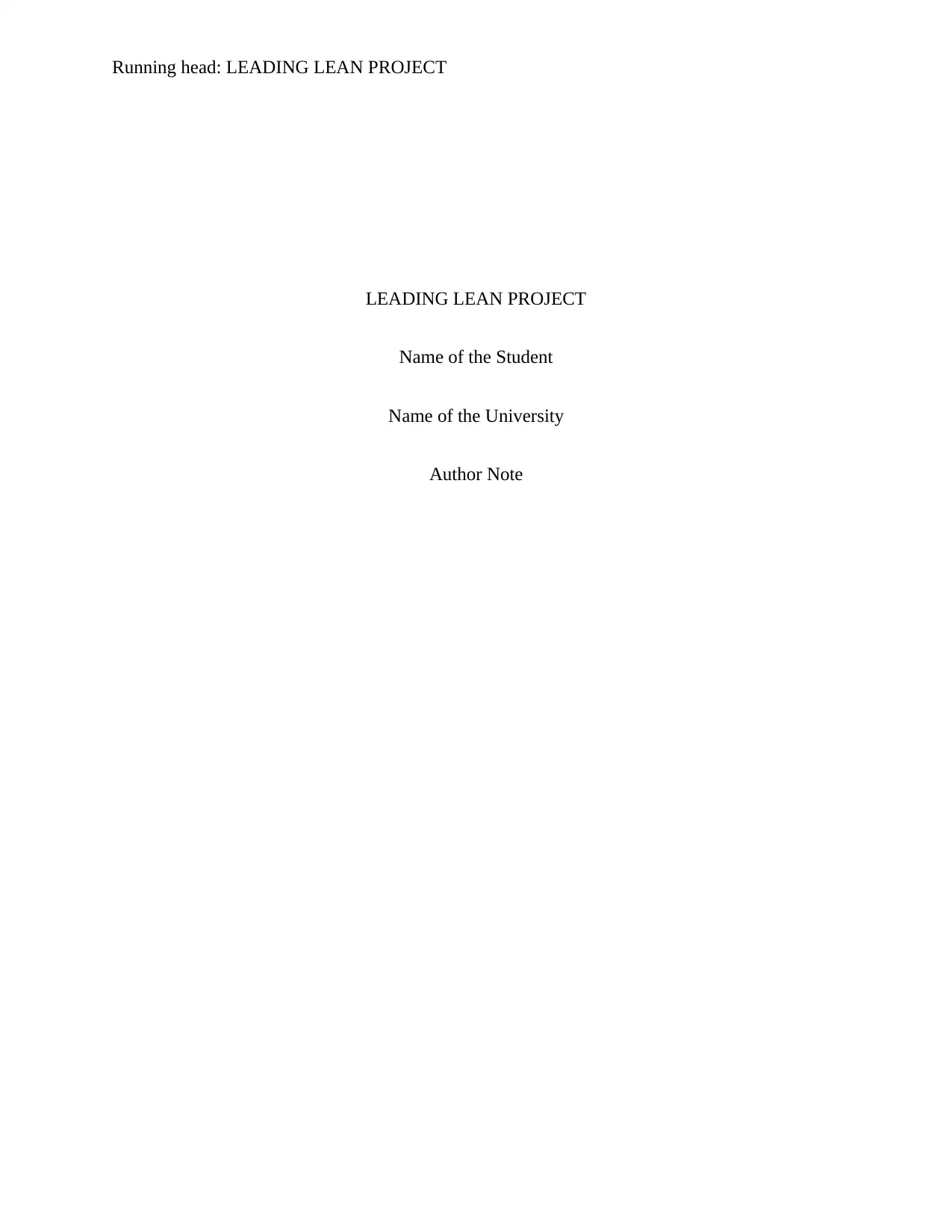
Running head: LEADING LEAN PROJECT
LEADING LEAN PROJECT
Name of the Student
Name of the University
Author Note
LEADING LEAN PROJECT
Name of the Student
Name of the University
Author Note
Secure Best Marks with AI Grader
Need help grading? Try our AI Grader for instant feedback on your assignments.
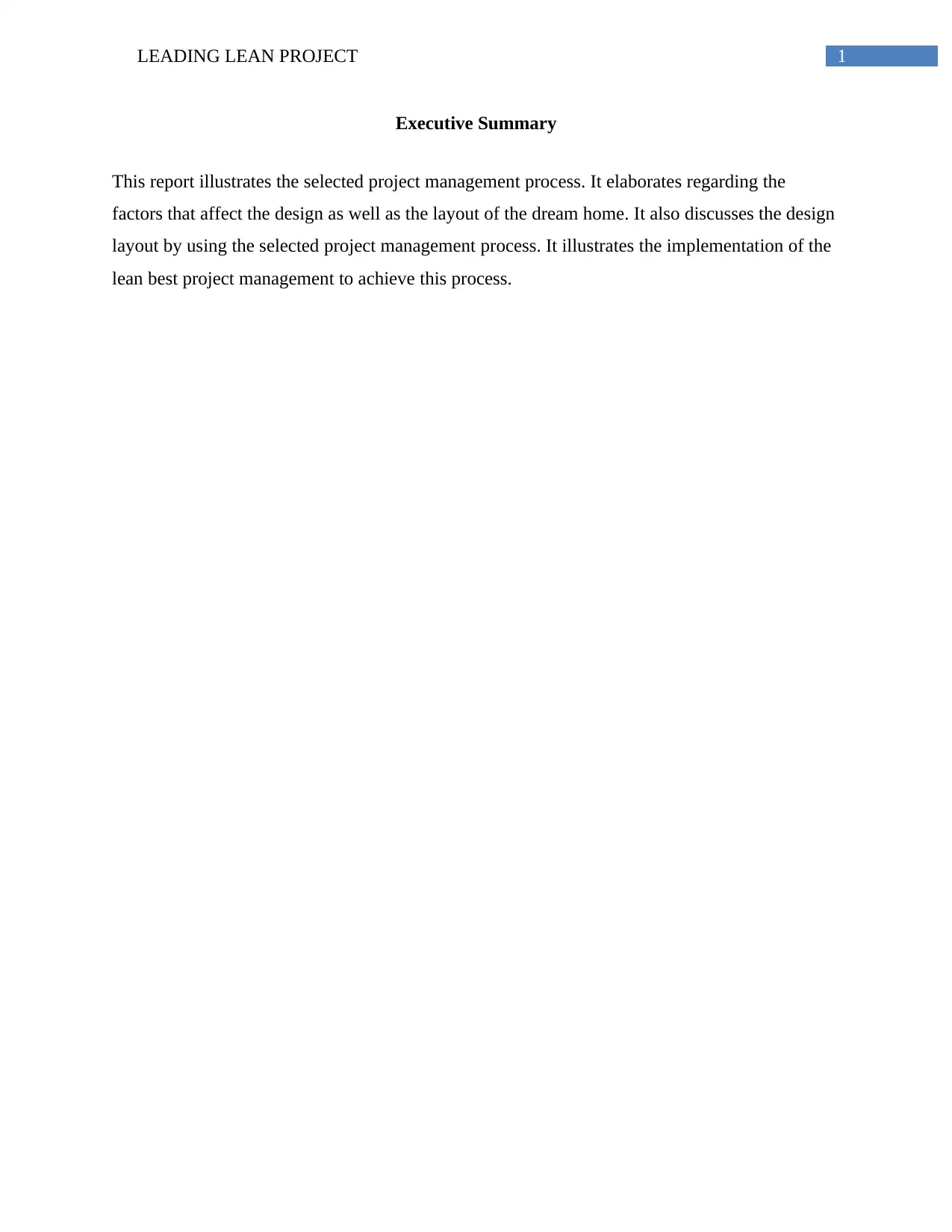
1LEADING LEAN PROJECT
Executive Summary
This report illustrates the selected project management process. It elaborates regarding the
factors that affect the design as well as the layout of the dream home. It also discusses the design
layout by using the selected project management process. It illustrates the implementation of the
lean best project management to achieve this process.
Executive Summary
This report illustrates the selected project management process. It elaborates regarding the
factors that affect the design as well as the layout of the dream home. It also discusses the design
layout by using the selected project management process. It illustrates the implementation of the
lean best project management to achieve this process.
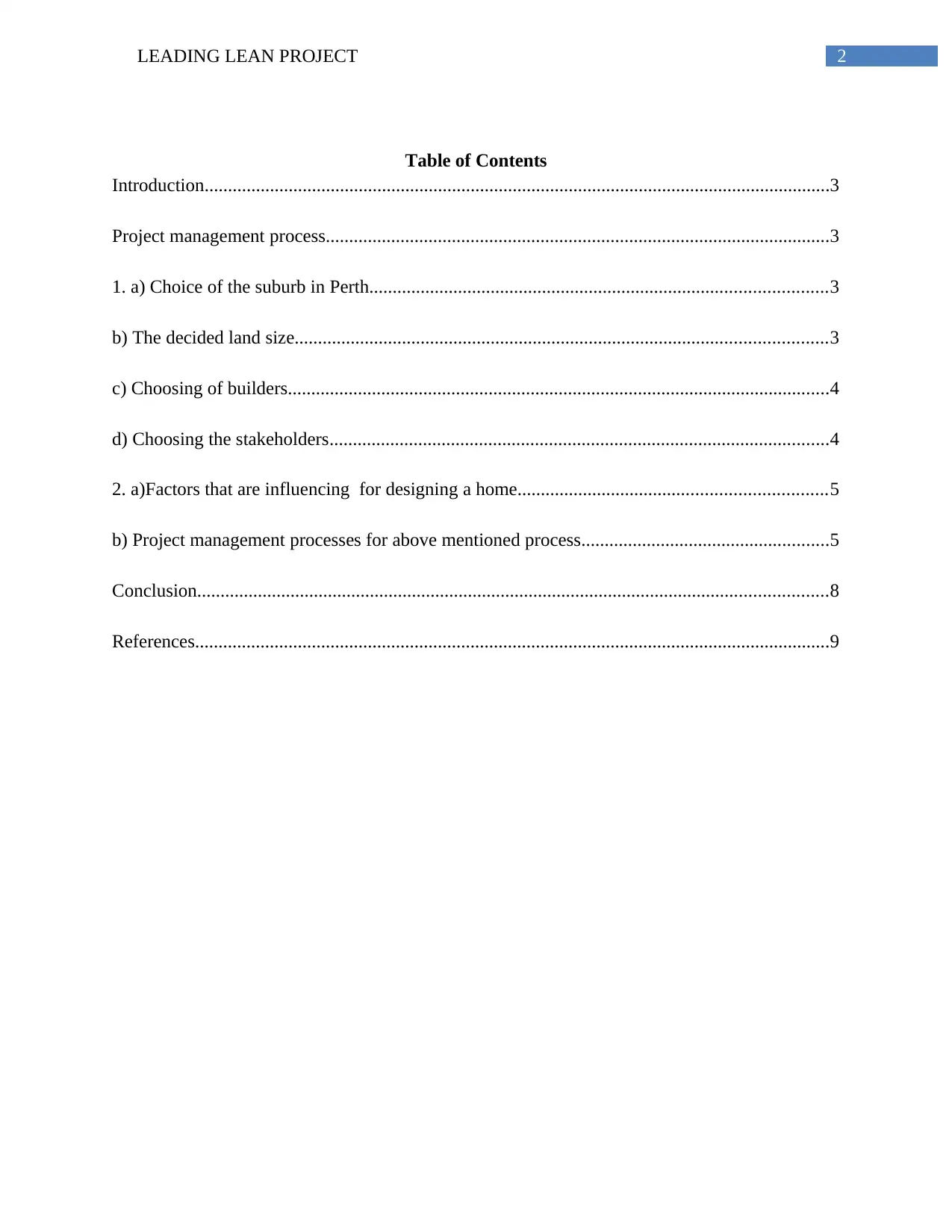
2LEADING LEAN PROJECT
Table of Contents
Introduction......................................................................................................................................3
Project management process............................................................................................................3
1. a) Choice of the suburb in Perth..................................................................................................3
b) The decided land size..................................................................................................................3
c) Choosing of builders....................................................................................................................4
d) Choosing the stakeholders...........................................................................................................4
2. a)Factors that are influencing for designing a home..................................................................5
b) Project management processes for above mentioned process.....................................................5
Conclusion.......................................................................................................................................8
References........................................................................................................................................9
Table of Contents
Introduction......................................................................................................................................3
Project management process............................................................................................................3
1. a) Choice of the suburb in Perth..................................................................................................3
b) The decided land size..................................................................................................................3
c) Choosing of builders....................................................................................................................4
d) Choosing the stakeholders...........................................................................................................4
2. a)Factors that are influencing for designing a home..................................................................5
b) Project management processes for above mentioned process.....................................................5
Conclusion.......................................................................................................................................8
References........................................................................................................................................9
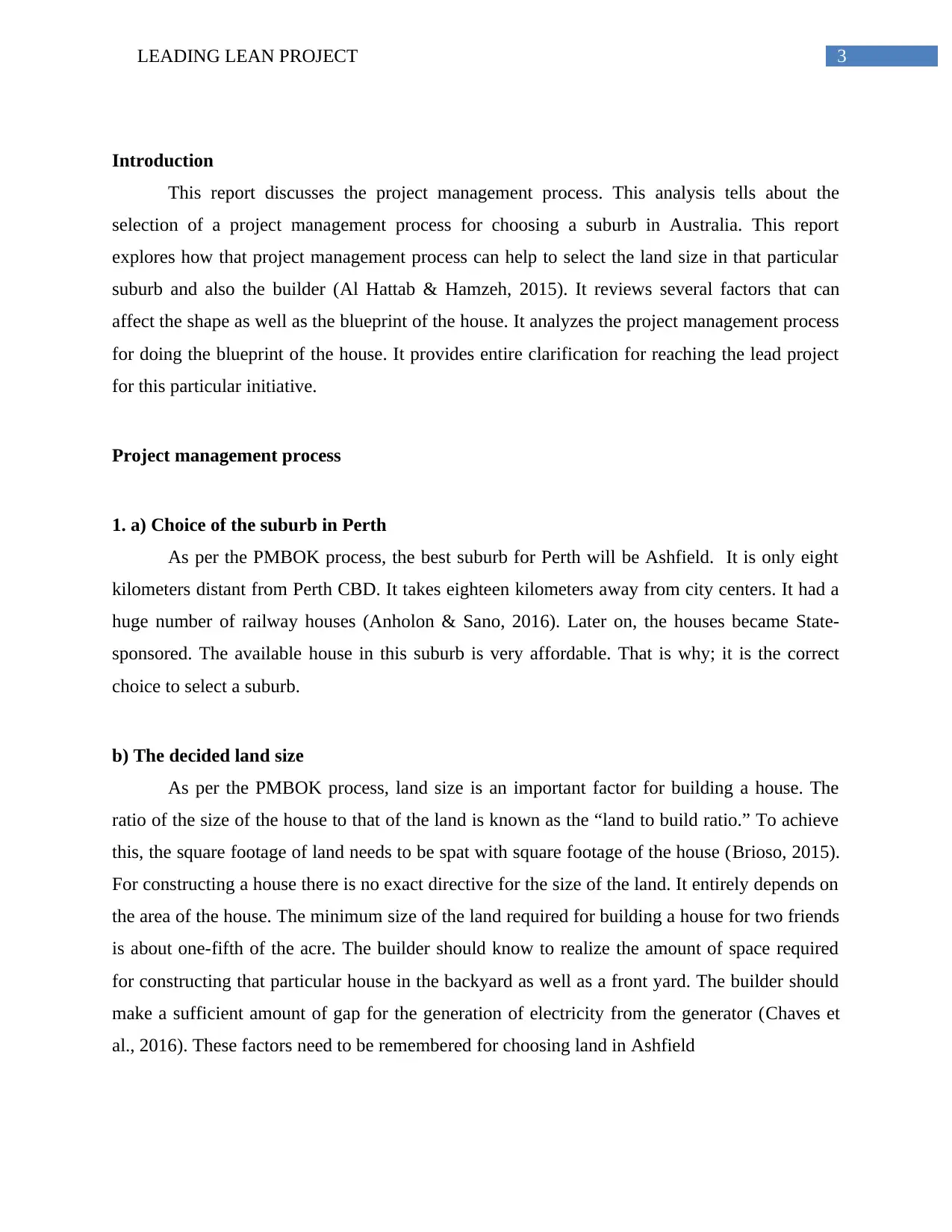
3LEADING LEAN PROJECT
Introduction
This report discusses the project management process. This analysis tells about the
selection of a project management process for choosing a suburb in Australia. This report
explores how that project management process can help to select the land size in that particular
suburb and also the builder (Al Hattab & Hamzeh, 2015). It reviews several factors that can
affect the shape as well as the blueprint of the house. It analyzes the project management process
for doing the blueprint of the house. It provides entire clarification for reaching the lead project
for this particular initiative.
Project management process
1. a) Choice of the suburb in Perth
As per the PMBOK process, the best suburb for Perth will be Ashfield. It is only eight
kilometers distant from Perth CBD. It takes eighteen kilometers away from city centers. It had a
huge number of railway houses (Anholon & Sano, 2016). Later on, the houses became State-
sponsored. The available house in this suburb is very affordable. That is why; it is the correct
choice to select a suburb.
b) The decided land size
As per the PMBOK process, land size is an important factor for building a house. The
ratio of the size of the house to that of the land is known as the “land to build ratio.” To achieve
this, the square footage of land needs to be spat with square footage of the house (Brioso, 2015).
For constructing a house there is no exact directive for the size of the land. It entirely depends on
the area of the house. The minimum size of the land required for building a house for two friends
is about one-fifth of the acre. The builder should know to realize the amount of space required
for constructing that particular house in the backyard as well as a front yard. The builder should
make a sufficient amount of gap for the generation of electricity from the generator (Chaves et
al., 2016). These factors need to be remembered for choosing land in Ashfield
Introduction
This report discusses the project management process. This analysis tells about the
selection of a project management process for choosing a suburb in Australia. This report
explores how that project management process can help to select the land size in that particular
suburb and also the builder (Al Hattab & Hamzeh, 2015). It reviews several factors that can
affect the shape as well as the blueprint of the house. It analyzes the project management process
for doing the blueprint of the house. It provides entire clarification for reaching the lead project
for this particular initiative.
Project management process
1. a) Choice of the suburb in Perth
As per the PMBOK process, the best suburb for Perth will be Ashfield. It is only eight
kilometers distant from Perth CBD. It takes eighteen kilometers away from city centers. It had a
huge number of railway houses (Anholon & Sano, 2016). Later on, the houses became State-
sponsored. The available house in this suburb is very affordable. That is why; it is the correct
choice to select a suburb.
b) The decided land size
As per the PMBOK process, land size is an important factor for building a house. The
ratio of the size of the house to that of the land is known as the “land to build ratio.” To achieve
this, the square footage of land needs to be spat with square footage of the house (Brioso, 2015).
For constructing a house there is no exact directive for the size of the land. It entirely depends on
the area of the house. The minimum size of the land required for building a house for two friends
is about one-fifth of the acre. The builder should know to realize the amount of space required
for constructing that particular house in the backyard as well as a front yard. The builder should
make a sufficient amount of gap for the generation of electricity from the generator (Chaves et
al., 2016). These factors need to be remembered for choosing land in Ashfield
Secure Best Marks with AI Grader
Need help grading? Try our AI Grader for instant feedback on your assignments.
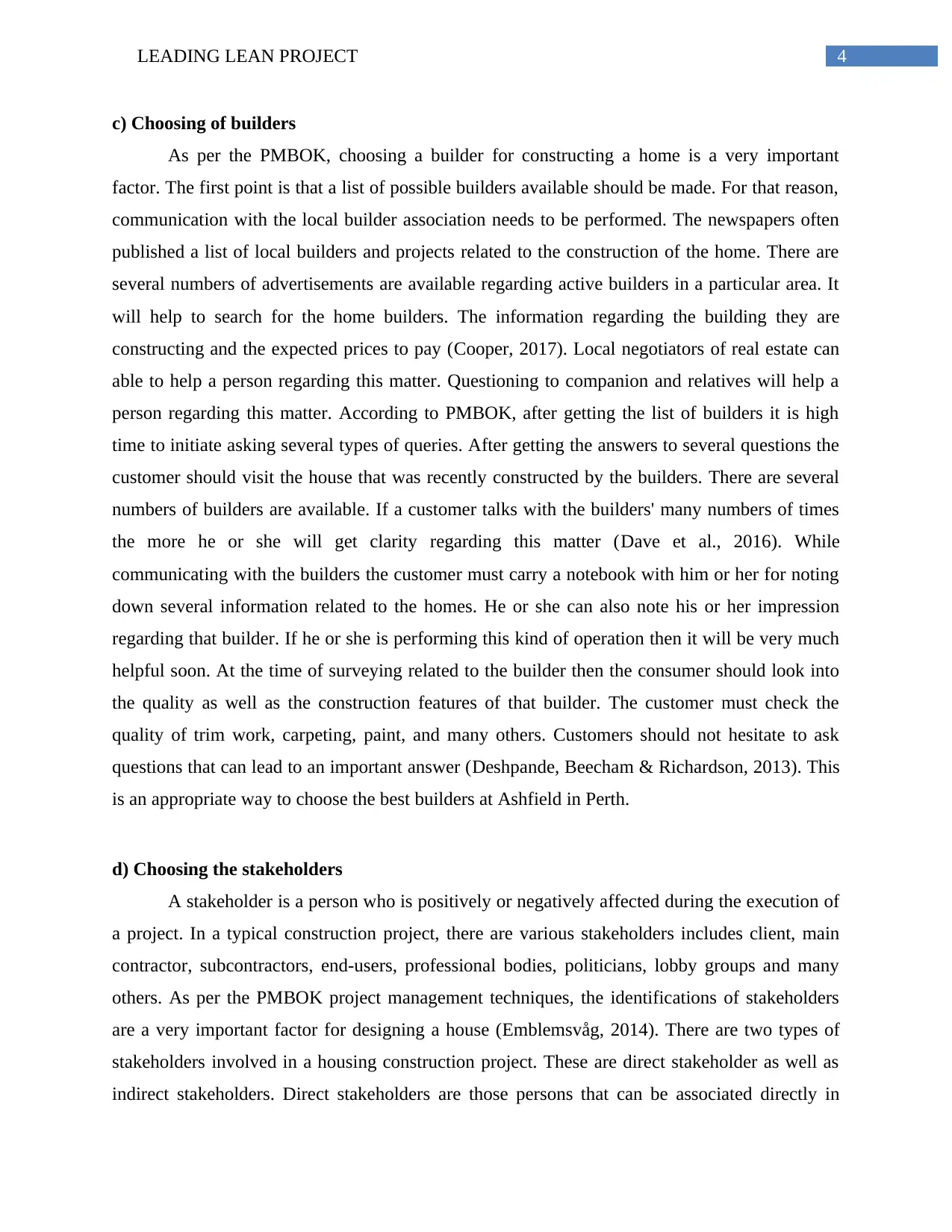
4LEADING LEAN PROJECT
c) Choosing of builders
As per the PMBOK, choosing a builder for constructing a home is a very important
factor. The first point is that a list of possible builders available should be made. For that reason,
communication with the local builder association needs to be performed. The newspapers often
published a list of local builders and projects related to the construction of the home. There are
several numbers of advertisements are available regarding active builders in a particular area. It
will help to search for the home builders. The information regarding the building they are
constructing and the expected prices to pay (Cooper, 2017). Local negotiators of real estate can
able to help a person regarding this matter. Questioning to companion and relatives will help a
person regarding this matter. According to PMBOK, after getting the list of builders it is high
time to initiate asking several types of queries. After getting the answers to several questions the
customer should visit the house that was recently constructed by the builders. There are several
numbers of builders are available. If a customer talks with the builders' many numbers of times
the more he or she will get clarity regarding this matter (Dave et al., 2016). While
communicating with the builders the customer must carry a notebook with him or her for noting
down several information related to the homes. He or she can also note his or her impression
regarding that builder. If he or she is performing this kind of operation then it will be very much
helpful soon. At the time of surveying related to the builder then the consumer should look into
the quality as well as the construction features of that builder. The customer must check the
quality of trim work, carpeting, paint, and many others. Customers should not hesitate to ask
questions that can lead to an important answer (Deshpande, Beecham & Richardson, 2013). This
is an appropriate way to choose the best builders at Ashfield in Perth.
d) Choosing the stakeholders
A stakeholder is a person who is positively or negatively affected during the execution of
a project. In a typical construction project, there are various stakeholders includes client, main
contractor, subcontractors, end-users, professional bodies, politicians, lobby groups and many
others. As per the PMBOK project management techniques, the identifications of stakeholders
are a very important factor for designing a house (Emblemsvåg, 2014). There are two types of
stakeholders involved in a housing construction project. These are direct stakeholder as well as
indirect stakeholders. Direct stakeholders are those persons that can be associated directly in
c) Choosing of builders
As per the PMBOK, choosing a builder for constructing a home is a very important
factor. The first point is that a list of possible builders available should be made. For that reason,
communication with the local builder association needs to be performed. The newspapers often
published a list of local builders and projects related to the construction of the home. There are
several numbers of advertisements are available regarding active builders in a particular area. It
will help to search for the home builders. The information regarding the building they are
constructing and the expected prices to pay (Cooper, 2017). Local negotiators of real estate can
able to help a person regarding this matter. Questioning to companion and relatives will help a
person regarding this matter. According to PMBOK, after getting the list of builders it is high
time to initiate asking several types of queries. After getting the answers to several questions the
customer should visit the house that was recently constructed by the builders. There are several
numbers of builders are available. If a customer talks with the builders' many numbers of times
the more he or she will get clarity regarding this matter (Dave et al., 2016). While
communicating with the builders the customer must carry a notebook with him or her for noting
down several information related to the homes. He or she can also note his or her impression
regarding that builder. If he or she is performing this kind of operation then it will be very much
helpful soon. At the time of surveying related to the builder then the consumer should look into
the quality as well as the construction features of that builder. The customer must check the
quality of trim work, carpeting, paint, and many others. Customers should not hesitate to ask
questions that can lead to an important answer (Deshpande, Beecham & Richardson, 2013). This
is an appropriate way to choose the best builders at Ashfield in Perth.
d) Choosing the stakeholders
A stakeholder is a person who is positively or negatively affected during the execution of
a project. In a typical construction project, there are various stakeholders includes client, main
contractor, subcontractors, end-users, professional bodies, politicians, lobby groups and many
others. As per the PMBOK project management techniques, the identifications of stakeholders
are a very important factor for designing a house (Emblemsvåg, 2014). There are two types of
stakeholders involved in a housing construction project. These are direct stakeholder as well as
indirect stakeholders. Direct stakeholders are those persons that can be associated directly in
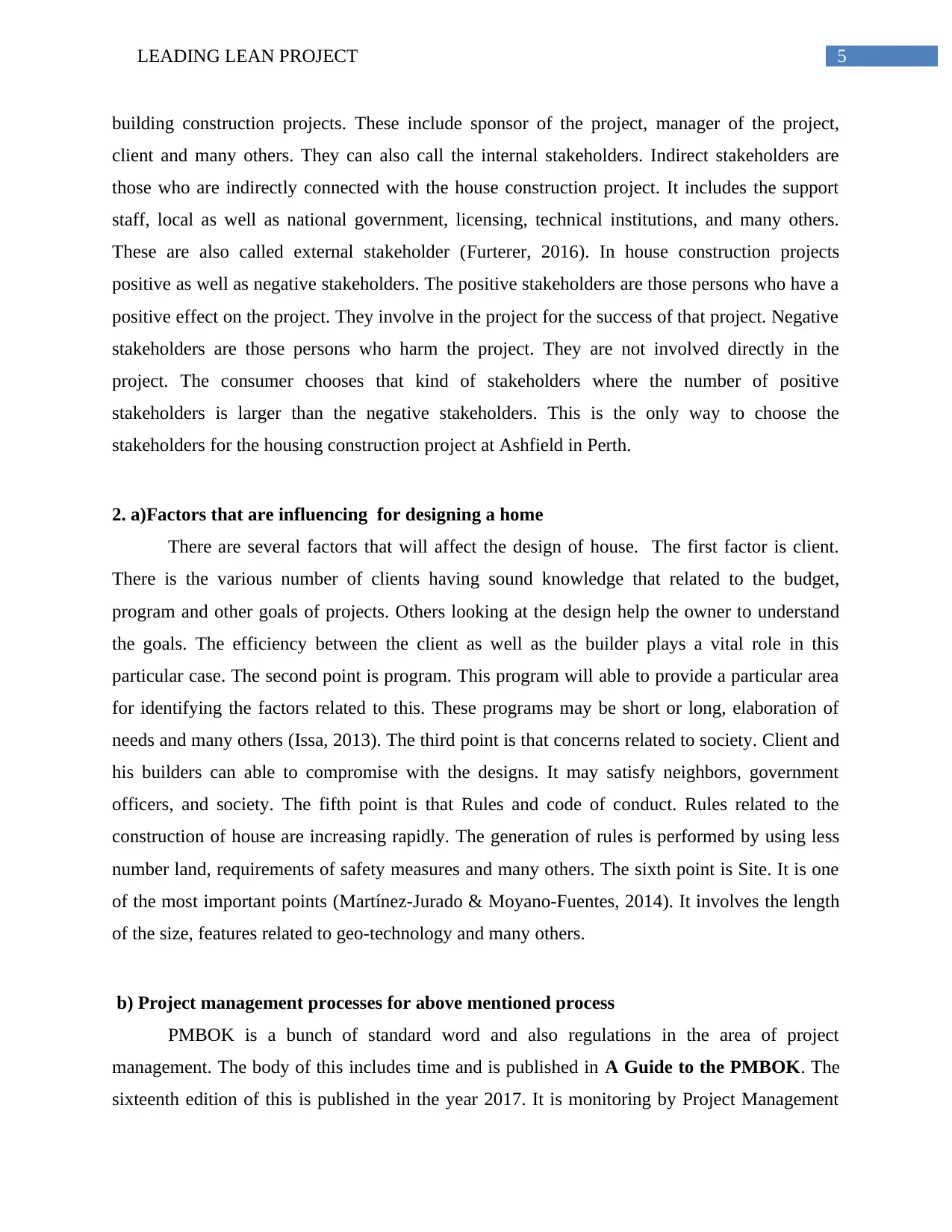
5LEADING LEAN PROJECT
building construction projects. These include sponsor of the project, manager of the project,
client and many others. They can also call the internal stakeholders. Indirect stakeholders are
those who are indirectly connected with the house construction project. It includes the support
staff, local as well as national government, licensing, technical institutions, and many others.
These are also called external stakeholder (Furterer, 2016). In house construction projects
positive as well as negative stakeholders. The positive stakeholders are those persons who have a
positive effect on the project. They involve in the project for the success of that project. Negative
stakeholders are those persons who harm the project. They are not involved directly in the
project. The consumer chooses that kind of stakeholders where the number of positive
stakeholders is larger than the negative stakeholders. This is the only way to choose the
stakeholders for the housing construction project at Ashfield in Perth.
2. a)Factors that are influencing for designing a home
There are several factors that will affect the design of house. The first factor is client.
There is the various number of clients having sound knowledge that related to the budget,
program and other goals of projects. Others looking at the design help the owner to understand
the goals. The efficiency between the client as well as the builder plays a vital role in this
particular case. The second point is program. This program will able to provide a particular area
for identifying the factors related to this. These programs may be short or long, elaboration of
needs and many others (Issa, 2013). The third point is that concerns related to society. Client and
his builders can able to compromise with the designs. It may satisfy neighbors, government
officers, and society. The fifth point is that Rules and code of conduct. Rules related to the
construction of house are increasing rapidly. The generation of rules is performed by using less
number land, requirements of safety measures and many others. The sixth point is Site. It is one
of the most important points (Martínez-Jurado & Moyano-Fuentes, 2014). It involves the length
of the size, features related to geo-technology and many others.
b) Project management processes for above mentioned process
PMBOK is a bunch of standard word and also regulations in the area of project
management. The body of this includes time and is published in A Guide to the PMBOK. The
sixteenth edition of this is published in the year 2017. It is monitoring by Project Management
building construction projects. These include sponsor of the project, manager of the project,
client and many others. They can also call the internal stakeholders. Indirect stakeholders are
those who are indirectly connected with the house construction project. It includes the support
staff, local as well as national government, licensing, technical institutions, and many others.
These are also called external stakeholder (Furterer, 2016). In house construction projects
positive as well as negative stakeholders. The positive stakeholders are those persons who have a
positive effect on the project. They involve in the project for the success of that project. Negative
stakeholders are those persons who harm the project. They are not involved directly in the
project. The consumer chooses that kind of stakeholders where the number of positive
stakeholders is larger than the negative stakeholders. This is the only way to choose the
stakeholders for the housing construction project at Ashfield in Perth.
2. a)Factors that are influencing for designing a home
There are several factors that will affect the design of house. The first factor is client.
There is the various number of clients having sound knowledge that related to the budget,
program and other goals of projects. Others looking at the design help the owner to understand
the goals. The efficiency between the client as well as the builder plays a vital role in this
particular case. The second point is program. This program will able to provide a particular area
for identifying the factors related to this. These programs may be short or long, elaboration of
needs and many others (Issa, 2013). The third point is that concerns related to society. Client and
his builders can able to compromise with the designs. It may satisfy neighbors, government
officers, and society. The fifth point is that Rules and code of conduct. Rules related to the
construction of house are increasing rapidly. The generation of rules is performed by using less
number land, requirements of safety measures and many others. The sixth point is Site. It is one
of the most important points (Martínez-Jurado & Moyano-Fuentes, 2014). It involves the length
of the size, features related to geo-technology and many others.
b) Project management processes for above mentioned process
PMBOK is a bunch of standard word and also regulations in the area of project
management. The body of this includes time and is published in A Guide to the PMBOK. The
sixteenth edition of this is published in the year 2017. It is monitoring by Project Management
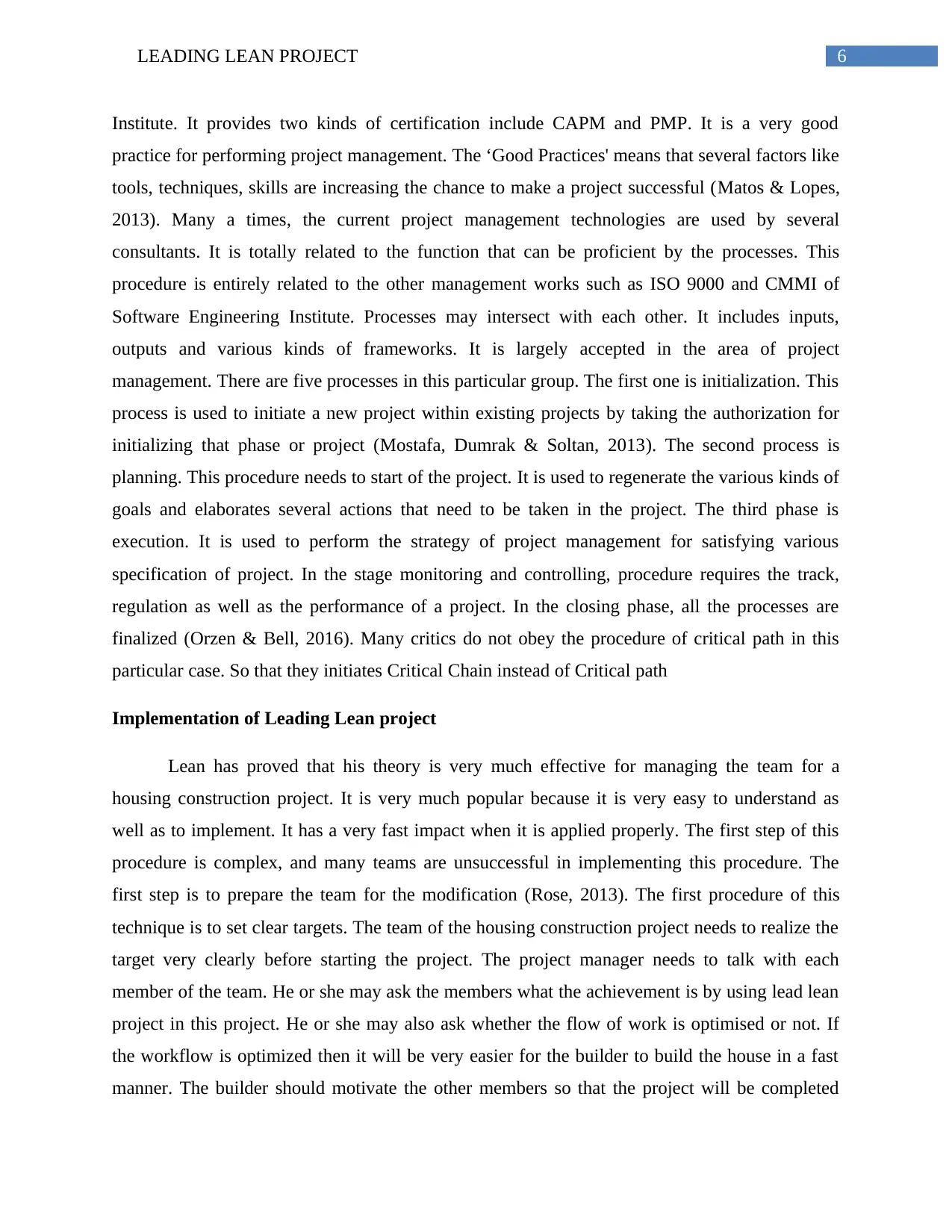
6LEADING LEAN PROJECT
Institute. It provides two kinds of certification include CAPM and PMP. It is a very good
practice for performing project management. The ‘Good Practices' means that several factors like
tools, techniques, skills are increasing the chance to make a project successful (Matos & Lopes,
2013). Many a times, the current project management technologies are used by several
consultants. It is totally related to the function that can be proficient by the processes. This
procedure is entirely related to the other management works such as ISO 9000 and CMMI of
Software Engineering Institute. Processes may intersect with each other. It includes inputs,
outputs and various kinds of frameworks. It is largely accepted in the area of project
management. There are five processes in this particular group. The first one is initialization. This
process is used to initiate a new project within existing projects by taking the authorization for
initializing that phase or project (Mostafa, Dumrak & Soltan, 2013). The second process is
planning. This procedure needs to start of the project. It is used to regenerate the various kinds of
goals and elaborates several actions that need to be taken in the project. The third phase is
execution. It is used to perform the strategy of project management for satisfying various
specification of project. In the stage monitoring and controlling, procedure requires the track,
regulation as well as the performance of a project. In the closing phase, all the processes are
finalized (Orzen & Bell, 2016). Many critics do not obey the procedure of critical path in this
particular case. So that they initiates Critical Chain instead of Critical path
Implementation of Leading Lean project
Lean has proved that his theory is very much effective for managing the team for a
housing construction project. It is very much popular because it is very easy to understand as
well as to implement. It has a very fast impact when it is applied properly. The first step of this
procedure is complex, and many teams are unsuccessful in implementing this procedure. The
first step is to prepare the team for the modification (Rose, 2013). The first procedure of this
technique is to set clear targets. The team of the housing construction project needs to realize the
target very clearly before starting the project. The project manager needs to talk with each
member of the team. He or she may ask the members what the achievement is by using lead lean
project in this project. He or she may also ask whether the flow of work is optimised or not. If
the workflow is optimized then it will be very easier for the builder to build the house in a fast
manner. The builder should motivate the other members so that the project will be completed
Institute. It provides two kinds of certification include CAPM and PMP. It is a very good
practice for performing project management. The ‘Good Practices' means that several factors like
tools, techniques, skills are increasing the chance to make a project successful (Matos & Lopes,
2013). Many a times, the current project management technologies are used by several
consultants. It is totally related to the function that can be proficient by the processes. This
procedure is entirely related to the other management works such as ISO 9000 and CMMI of
Software Engineering Institute. Processes may intersect with each other. It includes inputs,
outputs and various kinds of frameworks. It is largely accepted in the area of project
management. There are five processes in this particular group. The first one is initialization. This
process is used to initiate a new project within existing projects by taking the authorization for
initializing that phase or project (Mostafa, Dumrak & Soltan, 2013). The second process is
planning. This procedure needs to start of the project. It is used to regenerate the various kinds of
goals and elaborates several actions that need to be taken in the project. The third phase is
execution. It is used to perform the strategy of project management for satisfying various
specification of project. In the stage monitoring and controlling, procedure requires the track,
regulation as well as the performance of a project. In the closing phase, all the processes are
finalized (Orzen & Bell, 2016). Many critics do not obey the procedure of critical path in this
particular case. So that they initiates Critical Chain instead of Critical path
Implementation of Leading Lean project
Lean has proved that his theory is very much effective for managing the team for a
housing construction project. It is very much popular because it is very easy to understand as
well as to implement. It has a very fast impact when it is applied properly. The first step of this
procedure is complex, and many teams are unsuccessful in implementing this procedure. The
first step is to prepare the team for the modification (Rose, 2013). The first procedure of this
technique is to set clear targets. The team of the housing construction project needs to realize the
target very clearly before starting the project. The project manager needs to talk with each
member of the team. He or she may ask the members what the achievement is by using lead lean
project in this project. He or she may also ask whether the flow of work is optimised or not. If
the workflow is optimized then it will be very easier for the builder to build the house in a fast
manner. The builder should motivate the other members so that the project will be completed
Paraphrase This Document
Need a fresh take? Get an instant paraphrase of this document with our AI Paraphraser
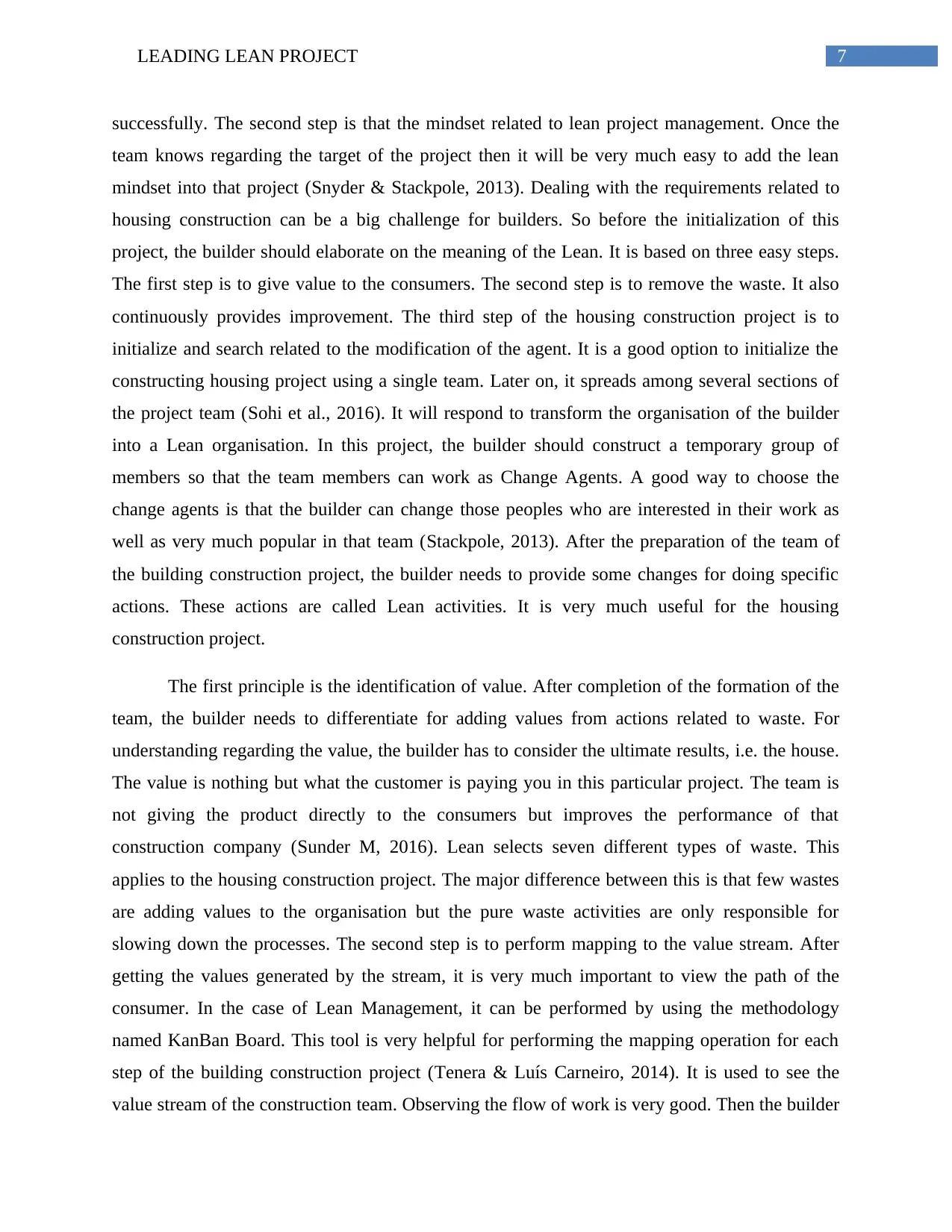
7LEADING LEAN PROJECT
successfully. The second step is that the mindset related to lean project management. Once the
team knows regarding the target of the project then it will be very much easy to add the lean
mindset into that project (Snyder & Stackpole, 2013). Dealing with the requirements related to
housing construction can be a big challenge for builders. So before the initialization of this
project, the builder should elaborate on the meaning of the Lean. It is based on three easy steps.
The first step is to give value to the consumers. The second step is to remove the waste. It also
continuously provides improvement. The third step of the housing construction project is to
initialize and search related to the modification of the agent. It is a good option to initialize the
constructing housing project using a single team. Later on, it spreads among several sections of
the project team (Sohi et al., 2016). It will respond to transform the organisation of the builder
into a Lean organisation. In this project, the builder should construct a temporary group of
members so that the team members can work as Change Agents. A good way to choose the
change agents is that the builder can change those peoples who are interested in their work as
well as very much popular in that team (Stackpole, 2013). After the preparation of the team of
the building construction project, the builder needs to provide some changes for doing specific
actions. These actions are called Lean activities. It is very much useful for the housing
construction project.
The first principle is the identification of value. After completion of the formation of the
team, the builder needs to differentiate for adding values from actions related to waste. For
understanding regarding the value, the builder has to consider the ultimate results, i.e. the house.
The value is nothing but what the customer is paying you in this particular project. The team is
not giving the product directly to the consumers but improves the performance of that
construction company (Sunder M, 2016). Lean selects seven different types of waste. This
applies to the housing construction project. The major difference between this is that few wastes
are adding values to the organisation but the pure waste activities are only responsible for
slowing down the processes. The second step is to perform mapping to the value stream. After
getting the values generated by the stream, it is very much important to view the path of the
consumer. In the case of Lean Management, it can be performed by using the methodology
named KanBan Board. This tool is very helpful for performing the mapping operation for each
step of the building construction project (Tenera & Luís Carneiro, 2014). It is used to see the
value stream of the construction team. Observing the flow of work is very good. Then the builder
successfully. The second step is that the mindset related to lean project management. Once the
team knows regarding the target of the project then it will be very much easy to add the lean
mindset into that project (Snyder & Stackpole, 2013). Dealing with the requirements related to
housing construction can be a big challenge for builders. So before the initialization of this
project, the builder should elaborate on the meaning of the Lean. It is based on three easy steps.
The first step is to give value to the consumers. The second step is to remove the waste. It also
continuously provides improvement. The third step of the housing construction project is to
initialize and search related to the modification of the agent. It is a good option to initialize the
constructing housing project using a single team. Later on, it spreads among several sections of
the project team (Sohi et al., 2016). It will respond to transform the organisation of the builder
into a Lean organisation. In this project, the builder should construct a temporary group of
members so that the team members can work as Change Agents. A good way to choose the
change agents is that the builder can change those peoples who are interested in their work as
well as very much popular in that team (Stackpole, 2013). After the preparation of the team of
the building construction project, the builder needs to provide some changes for doing specific
actions. These actions are called Lean activities. It is very much useful for the housing
construction project.
The first principle is the identification of value. After completion of the formation of the
team, the builder needs to differentiate for adding values from actions related to waste. For
understanding regarding the value, the builder has to consider the ultimate results, i.e. the house.
The value is nothing but what the customer is paying you in this particular project. The team is
not giving the product directly to the consumers but improves the performance of that
construction company (Sunder M, 2016). Lean selects seven different types of waste. This
applies to the housing construction project. The major difference between this is that few wastes
are adding values to the organisation but the pure waste activities are only responsible for
slowing down the processes. The second step is to perform mapping to the value stream. After
getting the values generated by the stream, it is very much important to view the path of the
consumer. In the case of Lean Management, it can be performed by using the methodology
named KanBan Board. This tool is very helpful for performing the mapping operation for each
step of the building construction project (Tenera & Luís Carneiro, 2014). It is used to see the
value stream of the construction team. Observing the flow of work is very good. Then the builder
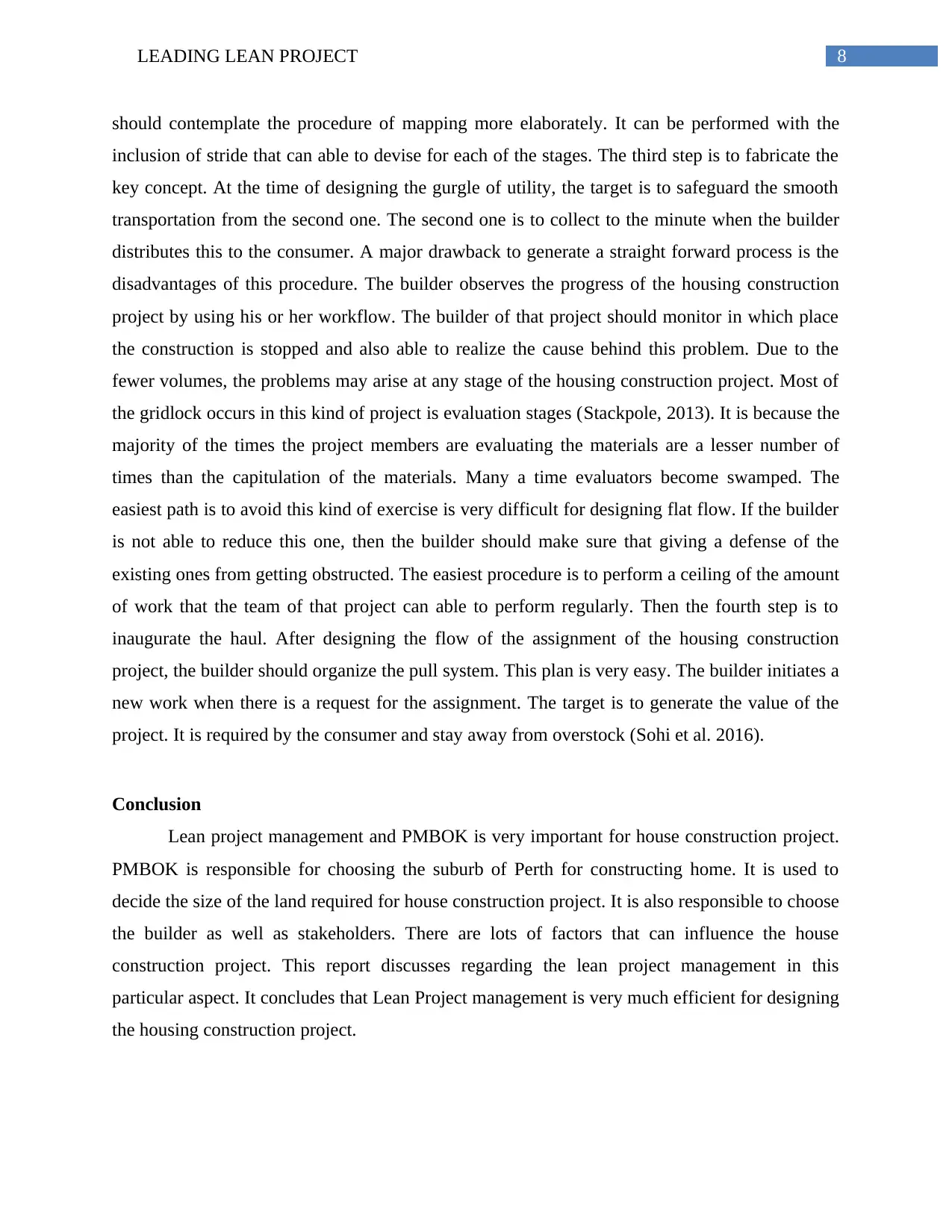
8LEADING LEAN PROJECT
should contemplate the procedure of mapping more elaborately. It can be performed with the
inclusion of stride that can able to devise for each of the stages. The third step is to fabricate the
key concept. At the time of designing the gurgle of utility, the target is to safeguard the smooth
transportation from the second one. The second one is to collect to the minute when the builder
distributes this to the consumer. A major drawback to generate a straight forward process is the
disadvantages of this procedure. The builder observes the progress of the housing construction
project by using his or her workflow. The builder of that project should monitor in which place
the construction is stopped and also able to realize the cause behind this problem. Due to the
fewer volumes, the problems may arise at any stage of the housing construction project. Most of
the gridlock occurs in this kind of project is evaluation stages (Stackpole, 2013). It is because the
majority of the times the project members are evaluating the materials are a lesser number of
times than the capitulation of the materials. Many a time evaluators become swamped. The
easiest path is to avoid this kind of exercise is very difficult for designing flat flow. If the builder
is not able to reduce this one, then the builder should make sure that giving a defense of the
existing ones from getting obstructed. The easiest procedure is to perform a ceiling of the amount
of work that the team of that project can able to perform regularly. Then the fourth step is to
inaugurate the haul. After designing the flow of the assignment of the housing construction
project, the builder should organize the pull system. This plan is very easy. The builder initiates a
new work when there is a request for the assignment. The target is to generate the value of the
project. It is required by the consumer and stay away from overstock (Sohi et al. 2016).
Conclusion
Lean project management and PMBOK is very important for house construction project.
PMBOK is responsible for choosing the suburb of Perth for constructing home. It is used to
decide the size of the land required for house construction project. It is also responsible to choose
the builder as well as stakeholders. There are lots of factors that can influence the house
construction project. This report discusses regarding the lean project management in this
particular aspect. It concludes that Lean Project management is very much efficient for designing
the housing construction project.
should contemplate the procedure of mapping more elaborately. It can be performed with the
inclusion of stride that can able to devise for each of the stages. The third step is to fabricate the
key concept. At the time of designing the gurgle of utility, the target is to safeguard the smooth
transportation from the second one. The second one is to collect to the minute when the builder
distributes this to the consumer. A major drawback to generate a straight forward process is the
disadvantages of this procedure. The builder observes the progress of the housing construction
project by using his or her workflow. The builder of that project should monitor in which place
the construction is stopped and also able to realize the cause behind this problem. Due to the
fewer volumes, the problems may arise at any stage of the housing construction project. Most of
the gridlock occurs in this kind of project is evaluation stages (Stackpole, 2013). It is because the
majority of the times the project members are evaluating the materials are a lesser number of
times than the capitulation of the materials. Many a time evaluators become swamped. The
easiest path is to avoid this kind of exercise is very difficult for designing flat flow. If the builder
is not able to reduce this one, then the builder should make sure that giving a defense of the
existing ones from getting obstructed. The easiest procedure is to perform a ceiling of the amount
of work that the team of that project can able to perform regularly. Then the fourth step is to
inaugurate the haul. After designing the flow of the assignment of the housing construction
project, the builder should organize the pull system. This plan is very easy. The builder initiates a
new work when there is a request for the assignment. The target is to generate the value of the
project. It is required by the consumer and stay away from overstock (Sohi et al. 2016).
Conclusion
Lean project management and PMBOK is very important for house construction project.
PMBOK is responsible for choosing the suburb of Perth for constructing home. It is used to
decide the size of the land required for house construction project. It is also responsible to choose
the builder as well as stakeholders. There are lots of factors that can influence the house
construction project. This report discusses regarding the lean project management in this
particular aspect. It concludes that Lean Project management is very much efficient for designing
the housing construction project.
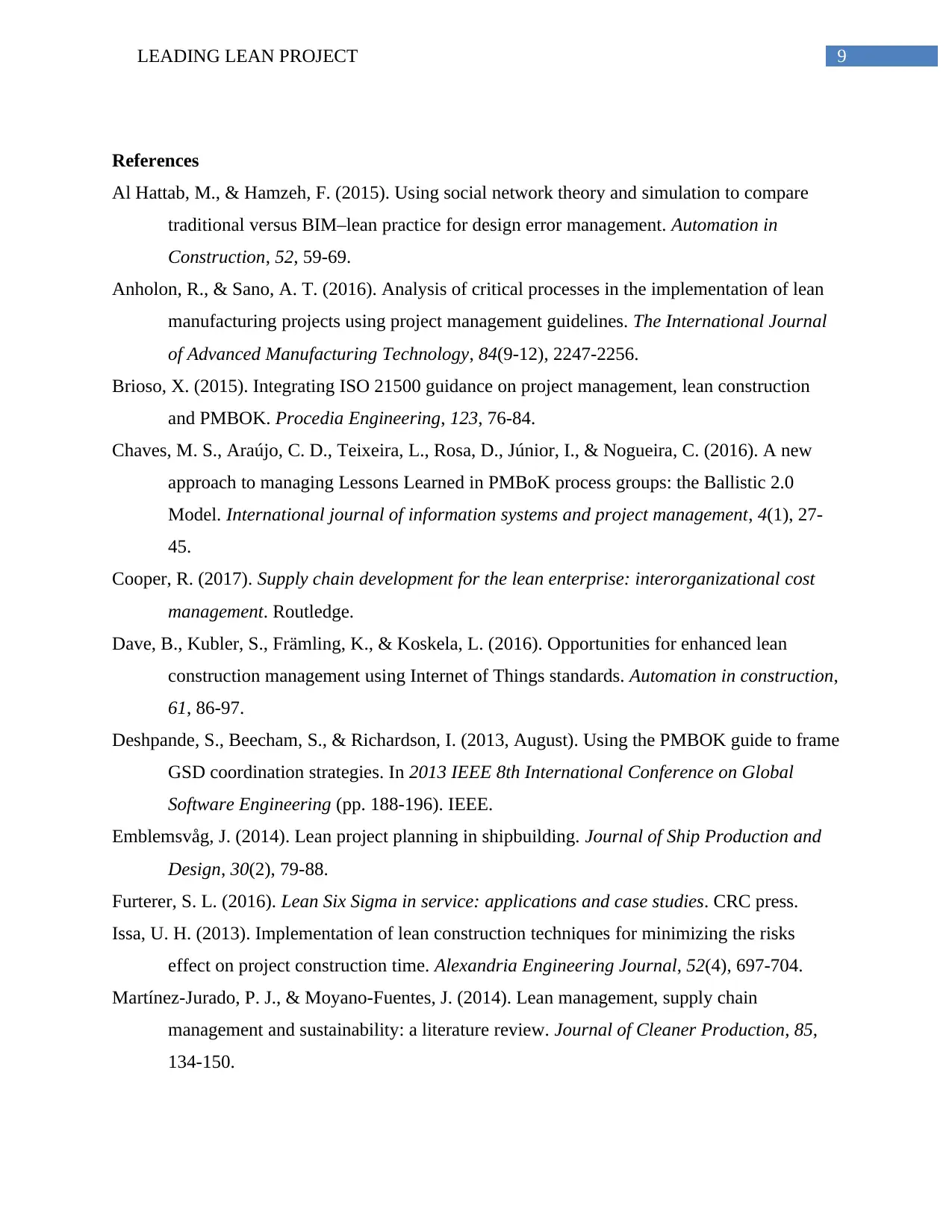
9LEADING LEAN PROJECT
References
Al Hattab, M., & Hamzeh, F. (2015). Using social network theory and simulation to compare
traditional versus BIM–lean practice for design error management. Automation in
Construction, 52, 59-69.
Anholon, R., & Sano, A. T. (2016). Analysis of critical processes in the implementation of lean
manufacturing projects using project management guidelines. The International Journal
of Advanced Manufacturing Technology, 84(9-12), 2247-2256.
Brioso, X. (2015). Integrating ISO 21500 guidance on project management, lean construction
and PMBOK. Procedia Engineering, 123, 76-84.
Chaves, M. S., Araújo, C. D., Teixeira, L., Rosa, D., Júnior, I., & Nogueira, C. (2016). A new
approach to managing Lessons Learned in PMBoK process groups: the Ballistic 2.0
Model. International journal of information systems and project management, 4(1), 27-
45.
Cooper, R. (2017). Supply chain development for the lean enterprise: interorganizational cost
management. Routledge.
Dave, B., Kubler, S., Främling, K., & Koskela, L. (2016). Opportunities for enhanced lean
construction management using Internet of Things standards. Automation in construction,
61, 86-97.
Deshpande, S., Beecham, S., & Richardson, I. (2013, August). Using the PMBOK guide to frame
GSD coordination strategies. In 2013 IEEE 8th International Conference on Global
Software Engineering (pp. 188-196). IEEE.
Emblemsvåg, J. (2014). Lean project planning in shipbuilding. Journal of Ship Production and
Design, 30(2), 79-88.
Furterer, S. L. (2016). Lean Six Sigma in service: applications and case studies. CRC press.
Issa, U. H. (2013). Implementation of lean construction techniques for minimizing the risks
effect on project construction time. Alexandria Engineering Journal, 52(4), 697-704.
Martínez-Jurado, P. J., & Moyano-Fuentes, J. (2014). Lean management, supply chain
management and sustainability: a literature review. Journal of Cleaner Production, 85,
134-150.
References
Al Hattab, M., & Hamzeh, F. (2015). Using social network theory and simulation to compare
traditional versus BIM–lean practice for design error management. Automation in
Construction, 52, 59-69.
Anholon, R., & Sano, A. T. (2016). Analysis of critical processes in the implementation of lean
manufacturing projects using project management guidelines. The International Journal
of Advanced Manufacturing Technology, 84(9-12), 2247-2256.
Brioso, X. (2015). Integrating ISO 21500 guidance on project management, lean construction
and PMBOK. Procedia Engineering, 123, 76-84.
Chaves, M. S., Araújo, C. D., Teixeira, L., Rosa, D., Júnior, I., & Nogueira, C. (2016). A new
approach to managing Lessons Learned in PMBoK process groups: the Ballistic 2.0
Model. International journal of information systems and project management, 4(1), 27-
45.
Cooper, R. (2017). Supply chain development for the lean enterprise: interorganizational cost
management. Routledge.
Dave, B., Kubler, S., Främling, K., & Koskela, L. (2016). Opportunities for enhanced lean
construction management using Internet of Things standards. Automation in construction,
61, 86-97.
Deshpande, S., Beecham, S., & Richardson, I. (2013, August). Using the PMBOK guide to frame
GSD coordination strategies. In 2013 IEEE 8th International Conference on Global
Software Engineering (pp. 188-196). IEEE.
Emblemsvåg, J. (2014). Lean project planning in shipbuilding. Journal of Ship Production and
Design, 30(2), 79-88.
Furterer, S. L. (2016). Lean Six Sigma in service: applications and case studies. CRC press.
Issa, U. H. (2013). Implementation of lean construction techniques for minimizing the risks
effect on project construction time. Alexandria Engineering Journal, 52(4), 697-704.
Martínez-Jurado, P. J., & Moyano-Fuentes, J. (2014). Lean management, supply chain
management and sustainability: a literature review. Journal of Cleaner Production, 85,
134-150.
Secure Best Marks with AI Grader
Need help grading? Try our AI Grader for instant feedback on your assignments.
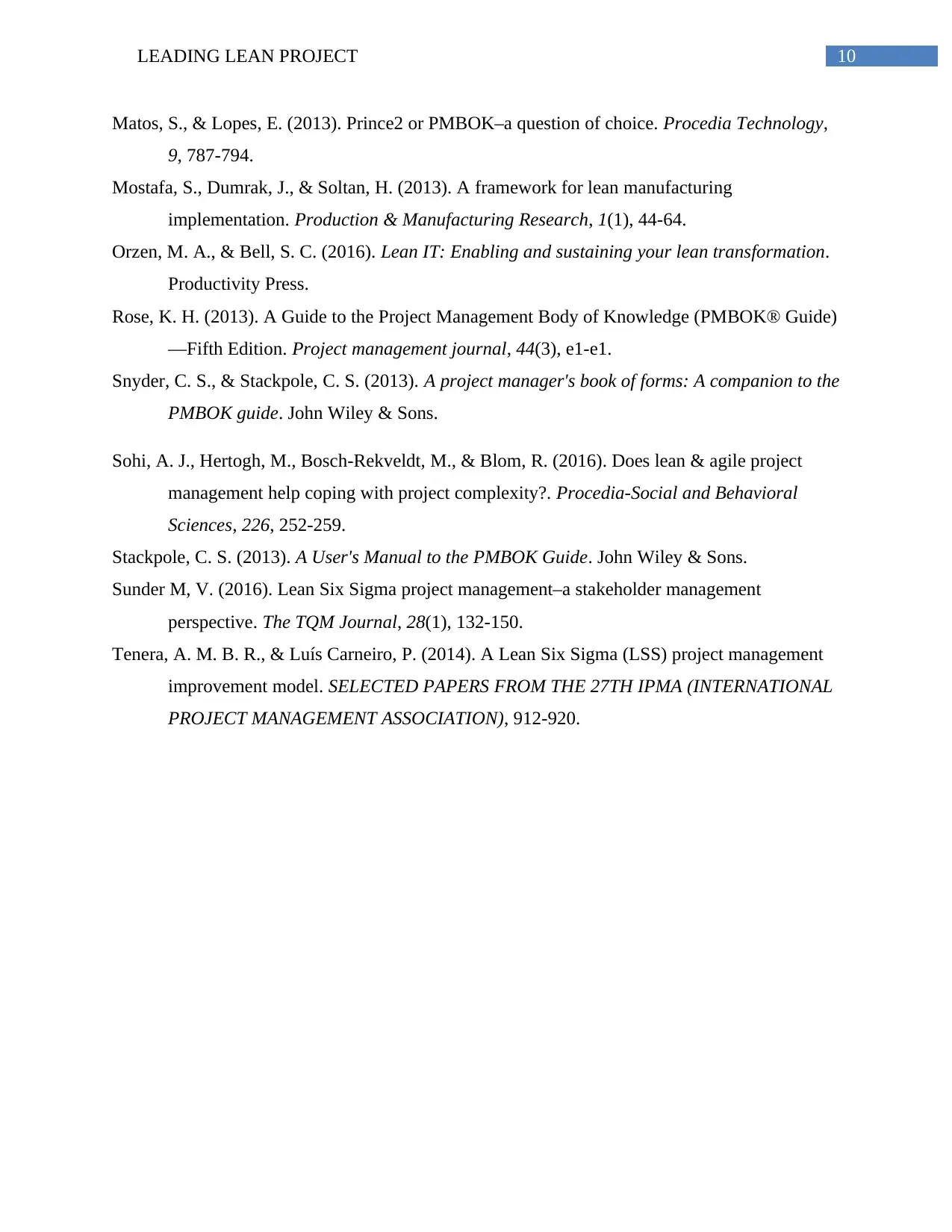
10LEADING LEAN PROJECT
Matos, S., & Lopes, E. (2013). Prince2 or PMBOK–a question of choice. Procedia Technology,
9, 787-794.
Mostafa, S., Dumrak, J., & Soltan, H. (2013). A framework for lean manufacturing
implementation. Production & Manufacturing Research, 1(1), 44-64.
Orzen, M. A., & Bell, S. C. (2016). Lean IT: Enabling and sustaining your lean transformation.
Productivity Press.
Rose, K. H. (2013). A Guide to the Project Management Body of Knowledge (PMBOK® Guide)
—Fifth Edition. Project management journal, 44(3), e1-e1.
Snyder, C. S., & Stackpole, C. S. (2013). A project manager's book of forms: A companion to the
PMBOK guide. John Wiley & Sons.
Sohi, A. J., Hertogh, M., Bosch-Rekveldt, M., & Blom, R. (2016). Does lean & agile project
management help coping with project complexity?. Procedia-Social and Behavioral
Sciences, 226, 252-259.
Stackpole, C. S. (2013). A User's Manual to the PMBOK Guide. John Wiley & Sons.
Sunder M, V. (2016). Lean Six Sigma project management–a stakeholder management
perspective. The TQM Journal, 28(1), 132-150.
Tenera, A. M. B. R., & Luís Carneiro, P. (2014). A Lean Six Sigma (LSS) project management
improvement model. SELECTED PAPERS FROM THE 27TH IPMA (INTERNATIONAL
PROJECT MANAGEMENT ASSOCIATION), 912-920.
Matos, S., & Lopes, E. (2013). Prince2 or PMBOK–a question of choice. Procedia Technology,
9, 787-794.
Mostafa, S., Dumrak, J., & Soltan, H. (2013). A framework for lean manufacturing
implementation. Production & Manufacturing Research, 1(1), 44-64.
Orzen, M. A., & Bell, S. C. (2016). Lean IT: Enabling and sustaining your lean transformation.
Productivity Press.
Rose, K. H. (2013). A Guide to the Project Management Body of Knowledge (PMBOK® Guide)
—Fifth Edition. Project management journal, 44(3), e1-e1.
Snyder, C. S., & Stackpole, C. S. (2013). A project manager's book of forms: A companion to the
PMBOK guide. John Wiley & Sons.
Sohi, A. J., Hertogh, M., Bosch-Rekveldt, M., & Blom, R. (2016). Does lean & agile project
management help coping with project complexity?. Procedia-Social and Behavioral
Sciences, 226, 252-259.
Stackpole, C. S. (2013). A User's Manual to the PMBOK Guide. John Wiley & Sons.
Sunder M, V. (2016). Lean Six Sigma project management–a stakeholder management
perspective. The TQM Journal, 28(1), 132-150.
Tenera, A. M. B. R., & Luís Carneiro, P. (2014). A Lean Six Sigma (LSS) project management
improvement model. SELECTED PAPERS FROM THE 27TH IPMA (INTERNATIONAL
PROJECT MANAGEMENT ASSOCIATION), 912-920.
1 out of 11
Related Documents
Your All-in-One AI-Powered Toolkit for Academic Success.
+13062052269
info@desklib.com
Available 24*7 on WhatsApp / Email
![[object Object]](/_next/static/media/star-bottom.7253800d.svg)
Unlock your academic potential
© 2024 | Zucol Services PVT LTD | All rights reserved.





